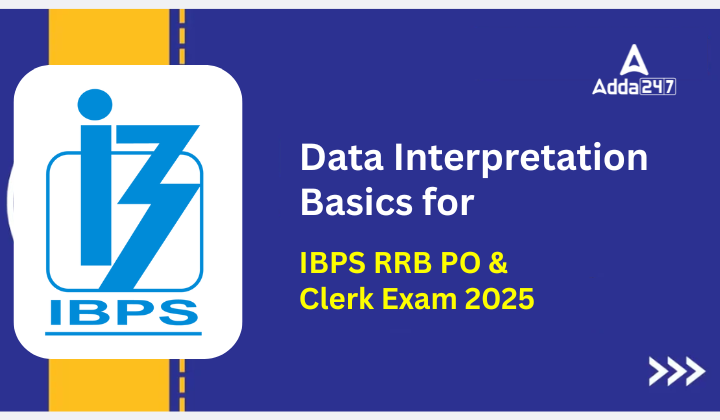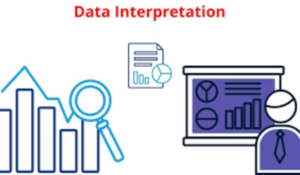Data Interpretation (DI) plays a crucial role in the IBPS RRB PO and Clerk Exam 2025, as well as in other banking, insurance, and government competitive exams. This section tests a candidate’s ability to analyze and draw conclusions from data presented in various formats such as tables, pie charts, bar graphs, line graphs, and more. To help you build a strong foundation, here are the key basics you need to master for success in Data Interpretation.
Data Interpretation Basics for IBPS RRB PO and Clerk Exam 2025
Data Interpretation is an important part of the IBPS RRB PO and Clerk Exam 2025, which tests your ability to analyse and interpret numerical data. Mastering the basics of charts, tables, and graphs is essential to solving questions efficiently and increasing your overall score in the Quantitative Aptitude section. Here we share types of Data Interpretation, approaches to solve DI problems, common DI question types, and many more things related to it.
1. Types of Data Interpretation
- Tables: Data presented in rows and columns. The key to solving DI questions based on tables is careful observation of the numbers.
- Bar Graphs: Visual representation of data using bars. Pay attention to the scale on the axis and the height of the bars.
- Pie Charts: Circular charts divided into sectors. Each sector represents a proportion of the total data. Understanding percentages and proportions is crucial here.
- Line Graphs: Shows data points connected by lines, often used to track changes over time.
- Radar Charts: These are often used for comparison between several variables in different categories.
- Caselets: A set of data presented in paragraphs or short cases. The data is usually non-tabular, and careful reading is required.
2. Key Skills for Solving DI
- Basic Arithmetic: Proficiency in addition, subtraction, multiplication, division, and percentages is crucial.
- Understanding Ratios & Proportions: This is often used when interpreting data.
- Reading Comprehension: DI questions might involve understanding and analyzing the context of the data. Be attentive to the information provided.
- Critical Thinking: DI questions often require you to think logically, interpret data correctly, and make the necessary calculations quickly.
3. Common DI Question Types
- Tabular Data Questions: Questions will ask you to compare or analyze the data presented in a table, such as finding the highest, lowest, or average value.
- Percentage-based Questions: Often involve calculating percentage growth, decrease, or comparing two categories.
- Time & Work Problems: Questions might involve calculating the time taken to complete tasks or understanding how work is distributed among different entities.
- Speed, Distance, and Time Questions: These are common in line graph problems that involve changes over time.
4. Approach to Solving DI Problems
- Read the Data Carefully: Make sure you understand what the data represents before answering any questions.
- Identify the Key Information: Focus on the key numbers or data points that are necessary to solve the question.
- Avoid Overcomplicating: DI questions can seem complex, but they are usually simple if you break them down logically.
- Use Approximation When Possible: In exams, time is limited, so approximating values (when necessary) can save time and effort.
5. Practice and Time Management
- Start with Simple Graphs and Tables: Initially, focus on solving problems with simple graphs or tables. As you become more confident, move to more complex datasets.
- Improve Speed: Try solving DI questions under timed conditions to simulate exam scenarios.
- Practice Regularly: The more you practice, the faster you’ll get at interpreting data and solving problems.
Data Interpretation Questions for IBPS RRB PO & Clerk
Directions (1–5): The following table shows the total no. senior citizen of different age group in Japan. Table also shows the ratio of male to female in them. Study the table carefully to answer the following questions.
| Age group (in year) | Total no. of senior citizen | Ratio of male to female |
| 50–60 | 2400 | 5 : 3 |
| 61–70 | 3200 | 3 : 1 |
| 71–80 | 4800 | 7 : 5 |
| 81–90 | 6000 | 2 : 1 |
Q1. Total no. of female senior citizens of age group (50–60) years are how much percent more or less than female senior citizens of age group (61–70) years?
(a) 12.5% more
(b) 12.5% less
(c) 10.5% more
(d) 10.5% less
(e) 8.5% more
Q2. What is the average no. of male senior citizens of age group (61–70) years and (81–90) years?
(a) 3600
(b) 2600
(c) 3200
(d) 2800
(e) 2300
Q3. If 3313% senior citizens of age group (81 –90) were died due to bad health then senior citizen now of this age group are what percent of total senior citizens of age group (61–70) years and (71–80) years together?
(a) 50%
(b) 60%
(c) 54%
(d) 64%
(e) 45%
Q4. If 20% male senior citizens of age group (71 –80) yrs are pensioners then how many male senior citizens are non–pensioner of the same age group?
(a) 2140
(b) 2440
(c) 2240
(d) 2420
(e) 2040
Q5. What is the difference between total male and total female senior citizen of age group (50 –60) and (61 –70) yrs together?
(a) 2300
(b) 2100
(c) 2400
(d) 2200
(e) 1850
Direction (6-10): Given below the table shows total number of room booked in five different hotels on five days of a week. Read the table carefully and answer the questions:
| Hotels | Monday | Tuesday | Wednesday | Thursday | Friday |
| Oberai | 360 | 280 | 560 | 520 | 480 |
| Lodhi | 260 | 275 | 225 | 215 | 305 |
| Taj | 640 | 480 | 290 | 375 | 275 |
| Grand | 280 | 250 | 300 | 720 | 220 |
| Eros | 155 | 145 | 265 | 275 | 315 |
Q6. Total rooms booked in ‘Oberai’ on Tuesday & Thursday together is what percent less than total rooms booked in ‘Grand’ on Monday & Thursday?
(a)25%
(b)20%
(c)16%
(d)34%
(e)48%
Q7. Find difference between total number of rooms booked in ‘Oberai’, ‘Lodhi’ & ‘Taj’ on Monday together and total number of rooms booked in ‘Taj’ , ‘Grand’& ‘Eros’ on Thursday together?
(a)140
(b)210
(c)70
(d)110
(e)135
Q8. Find ratio between total rooms booked in ‘Eros’ on Wednesday & Thursday together to total rooms booked in ‘Lodhi’ on Thursday & Friday together?
(a)27: 26
(b)19: 17
(c)29: 32
(d)53 :49
(e)24: 23
Q9. Find sum of average numbers of room booked in ‘Eros’ on Monday, Wednesday & Friday and average number of rooms booked in ‘Grand’ on Monday & Friday?
(a)580
(b)380
(c)495
(d)460
(e)535
Q10. Find percentage increase in rooms booked on Friday in ‘Oberai’ over total rooms booked on Monday in same Hotel?
(a)46%
(b)66 2/3%
(c)37 1/2%
(d)28%
(e)33 1/3%
| Related Posts | |
| IBPS Calendar 2025 | |
| IBPS Clerk Exam Date 2025 | IBPS SO Exam Date 2025 |
| IBPS RRB PO Salary | |
| IBPS RRB PO Cut Off |
|
| IBPS RRB PO Syllabus |
|




 SBI Clerk 2026 Notification, Exam Date, ...
SBI Clerk 2026 Notification, Exam Date, ...
 Data Interpretation (Line/Bar Graph) for...
Data Interpretation (Line/Bar Graph) for...
 Daily Current Affairs Quiz 2025 15 Decem...
Daily Current Affairs Quiz 2025 15 Decem...







